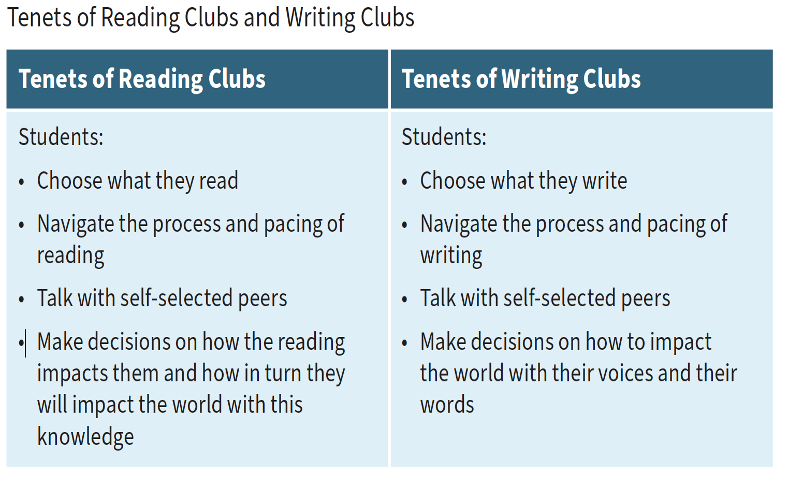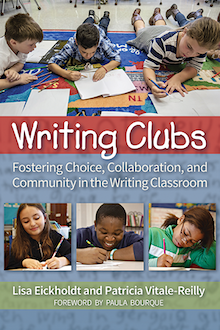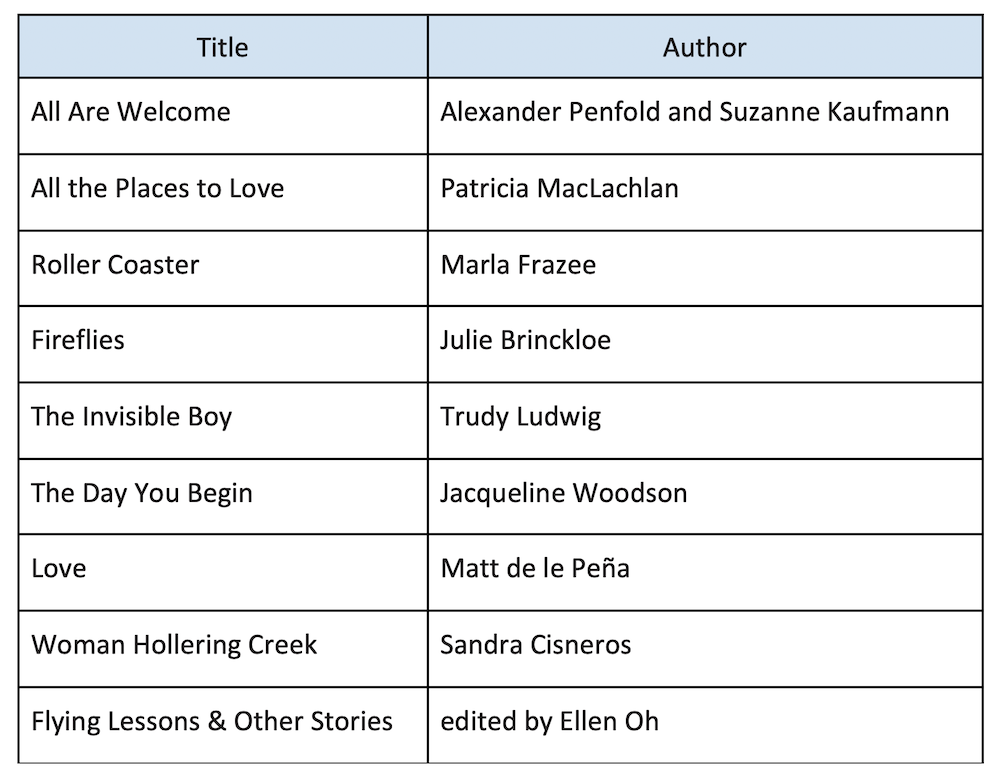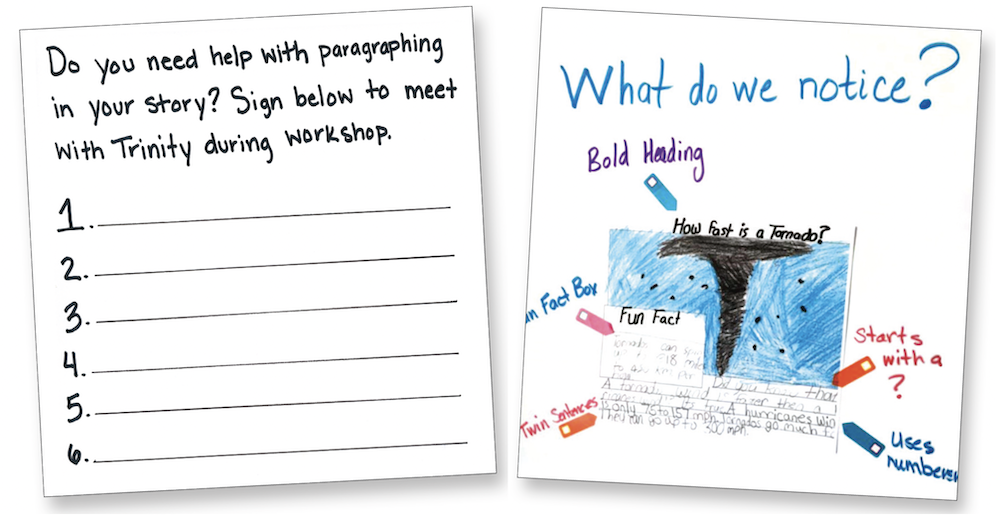Building a Foundation for In-Class Writing Clubs
By Lisa Eickholdt and Patty Vitale-Reilly
Heading back to school is simultaneously nerve-wracking and joyous.
We want to quickly get the year going (and get to the good stuff!), but we also want to connect to students and create a classroom community where students can thrive independently and collaboratively.

Patty Vitale-Reilly
Many of us use collaborations in reading and writing, and our own favorite collaboration is a writing club. What is a writing club? Just like a reading club, a writing club is an opportunity to work in authentic, engaging, and collaborative ways.
Students choose what to write, navigate the process and pacing of writing, talk with self-selected peers, and make decisions on how to impact the world with their voices and their words.
 In order to lay the foundation for writing clubs, we begin by making students feel safe and part of a writing community. Creating a classroom community is one of the most vital aspects of teaching. No matter how sound our pedagogy or how well-crafted our techniques, if students don’t feel like they are part of a group, learning will not occur (Petersen 1992)
In order to lay the foundation for writing clubs, we begin by making students feel safe and part of a writing community. Creating a classroom community is one of the most vital aspects of teaching. No matter how sound our pedagogy or how well-crafted our techniques, if students don’t feel like they are part of a group, learning will not occur (Petersen 1992)
Here are our top five ways to build community and create a foundation for writing clubs.
Start with Read Alouds.
One of our favorite ways to help students get to know one another is by reading aloud. Sharing beautiful picture books, poetry, short stories, and current events about common human experiences evokes memories of similar experiences – memories they want to share.
After the read-aloud, we share the memories the book triggered for us. When we share our stories and humorous anecdotes about family and friends, students open up. Talk soon fills the room as partners and small groups organically form around shared experiences. Through storytelling, we learn we are more alike than different.
Favorite Read-Alouds for the Beginning of the Year
Use Getting-to-Know-You Writing Exercises.
Another way that we build community and prepare students to work in powerful and productive collaborations is to engage them in some short writing exercises. These exercises help us get to know our kids, and, more importantly, help them get to know one another. Two of our favorites are:
● Six-Word Memoirs. We invite students to reveal themselves through very short stories or six-word memoirs. Legend has it that Ernest Hemingway was once challenged to write a full story in six words. Hemingway famously responded with: “For Sale: baby shoes, never worn.” Kids love writing and sharing these with one another and the world via the hashtag #SixWordStories.
● Humans of New York. Literacy teacher extraordinaire, Jessica Lifshitz (@Jess5th), taught us to harness the power of human interest stories by imitating the famous Human of New York (HONY) website. The HONY project includes photographs and brief stories about the inhabitants of New York City. In our classrooms we can take pictures of our students (or allow them to create self-portraits) and then have students craft short stories about experiences from their lives.
Implement Feedback Structures.
Regardless of the approach you use for writing, one common feature is a share session or wrap-up at the end of the writing time. The share is powerful in many ways because it provides time for students to acknowledge, reflect, reiterate, and share ideas.
This time is also ideal for introducing feedback structures that enable students to get to know one another as writers and move them toward writing collaborations. One of our favorite ways to share is a structure that one of Patty’s classes once called “Sitting in the Chair.” (Graves and Hansen 1983). It goes like this:
● Each day one writer sits in the feedback chair. In Patty’s classroom, this was just the chair that Patty typically sat in during minilessons. Here, she gave the chair to a writer in the class, and she joined the rest of the writers in the meeting area.
● The writer asks the community to give feedback on a part of their writing. We limit the selection to be either one sentence or one paragraph because we want to fit this practice into the typical timing of the share – between five and ten minutes. The writer asks for specific feedback (Does my lead engage you as a reader? Can you follow the dialogue in this scene? Does my word choice pack a punch?) and then reads the part.
● Students listen to the writer and then implement a simple feedback structure called “a glow and a grow.” A “glow” is a compliment about what a writer is doing well, and a “grow” is constructive feedback. Through this activity, each writer learns to ask for and take in feedback as well as how to provide feedback that is positive and powerful.
Identify Student Expertise.
We enjoy discovering each child’s strengths and using this knowledge to create an expert list (Vitale-Reilly 2018). To create this list, we talk to kids about their writing and observe them as they work with peers. As we informally assess our students, we are looking for what they are good at.
As we confer, we take note when a student has lots of ideas in their notebook and inquire how they accomplished it. We share their response with the rest of the class and add “idea generation” under their name on our expert chart. We notice when a student finds a unique way to plan and add “planning” under their name on the list. We pay attention to the students who seek out for assistance with spelling or drawing and add “editing” and “illustrating” under their names.
Assessing with an eye toward what students can do and ways they can mentor each other creates a culture of respect. It also conveys an important idea to students: everyone in this classroom has something worthy to offer (Eickholdt 2015).
Establish Partnerships.
Once we’ve established some whole-class structures and have gotten to know each other as people and as writers, students are ready to begin collaborating. We like to begin small, so we start with partnerships.
Before assigning students a long-term partner, we make sure every child has the opportunity to collaborate with every person in the class at least once. We call this speed partnering, and the goal is for students to have the opportunity to briefly work and talk with everyone in the class, even for just five to ten minutes.
We provide partner opportunities throughout our workshop: we ask students to partner during the minilesson and work together, to partner during writing to make plans and share ideas, and to partner at the end of writing to share their work. After each partnership experience, we ask students to jot down one positive thing about their partner or the experience in their notebooks to refer to later.
Speed partnering shows students that every child has unique qualities that may make them a good fit as a partner. We keep track of this speed dating on a grid so we can be sure each child has had the opportunity to work with everyone in the class.
After a few weeks of partnering, we ask students to look back at their notes and list several students they’d like to work with for a while (writing partners are long term, usually throughout the duration of a unit, but not for the entire year). We then use students’ requests, our notes from observations, and information from the class expert list to create what we hope will be the first of many well-matched collaborations throughout the year.
The Natural Next Step: Writing Collaborations
After building a writing community that values every student as a person and a writer, and after teaching students how to talk to their peers in a constructive manner, writing collaborations are a natural next step. Starting the year in these exciting and joyous ways will lay the foundation for creating successful writing clubs throughout the year.
Read Katie Durkin’s MiddleWeb review of Lisa and Patty’s
Writing Clubs: Fostering Choice, Collaboration, and Community in the Writing Classroom.

Education consultant Patty Vitale-Reilly has taught in both public and independent schools as well as at the graduate level. She currently works with school leaders, coaches, teachers, and students inside and outside of classrooms. The books she has written include The Complete Year in Reading and Writing Grade 2 (Scholastic, 2008), Engaging Every Learner and Supporting Struggling Learners (Heinemann, 2015) and Supporting Struggling Learners: 50 Instructional Moves for the Classroom Teacher (Heinemann, 2017).

































